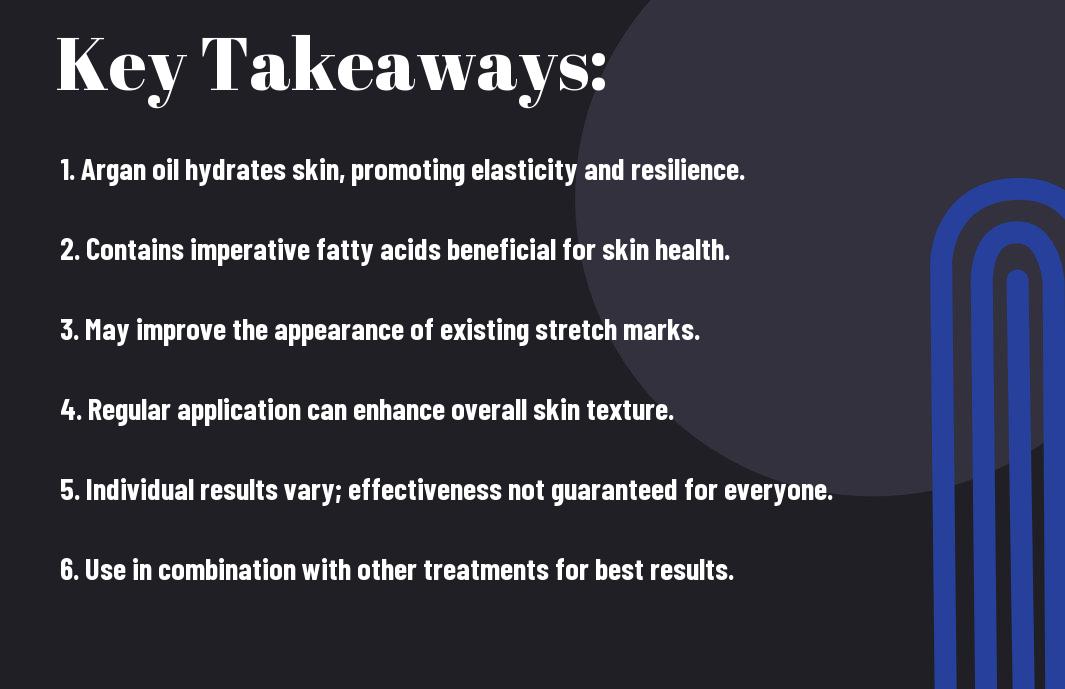Stretch marks can be a common concern for many individuals, often resulting from factors like pregnancy, weight changes, or growth spurts. If you’re looking for natural remedies to improve your skin’s appearance, you might wonder about the effectiveness of argan oil in reducing these marks. This blog post will explore the properties of argan oil, its benefits for skin health, and the research surrounding its use for treating stretch marks. You’ll gain insights into how this oil can potentially enhance your skincare routine and help diminish the appearance of those stubborn marks.


Understanding Stretch Marks
As you experience significant changes in your body, such as during pregnancy, rapid weight gain, or puberty, you may notice the presence of stretch marks. These skin marks, medically known as striae, typically appear as linear streaks and can vary in color, ranging from red and purple to white and silver. Stretch marks occur when your skin’s elastic fibers become overstretched, leading to visible scars that impact both appearance and self-esteem.
Causes of Stretch Marks
Above all, various factors contribute to the development of stretch marks. Rapid changes in body size or shape, hormonal fluctuations, genetics, and certain medical conditions can all increase your likelihood of experiencing these skin marks. It’s imperative to understand that even healthy individuals may develop stretch marks, as they are a natural response of the skin to significant stretching.
Stages of Stretch Mark Development
Stretch marks often progress through several stages before they become permanent. Initially, they may appear as red, purple, or dark brown streaks, depending on your skin tone. Over time, these marks often fade to lighter shades, transitioning to white or silver as they mature. The early red or dark marks may be more responsive to treatment, while the older, lighter ones may require more effort to reduce.
Understanding the stages of stretch mark development can help you address them effectively. In the early stages, when marks are still red or purple, your skin may have more blood flow and be more responsive to topical treatments. As the marks become older and fade to white or silver, they become less pronounced but more challenging to treat. Being proactive in the early stages can maximize your chances of minimizing their appearance.

Overview of Argan Oil
Any discussion about natural skincare wouldn’t be complete without mentioning argan oil. This luxurious oil, derived from the nuts of the argan tree native to Morocco, is renowned for its versatile benefits. Rich in antioxidants, vital fatty acids, and vitamins, argan oil is often celebrated for its ability to hydrate, nourish, and protect your skin. Its unique composition makes it a valuable ally in your quest for healthy, supple skin, making it worth considering for your skincare regimen.
Nutritional Composition
Around 80% of argan oil consists of unsaturated fatty acids, particularly oleic and linoleic acids, which are key for maintaining skin elasticity. Packed with vitamin E, this oil also contributes significantly to skin repair and regeneration. The presence of antioxidants further enhances its potential, helping to combat oxidative stress. Together, these components create a nutrient-rich formula that supports your skin’s health and vitality.
Historical Uses and Traditions
Behind argan oil’s modern acclaim lies a rich history rooted in Moroccan culture. Traditionally, Berber women have used this precious oil for centuries, utilizing it in cooking, cosmetics, and medicinal practices. Known locally as “liquid gold,” it has been applied to nourish both skin and hair, serving as a moisturizer in dry climates. This deep-rooted tradition highlights argan oil’s significance as not just a beauty commodity but also a staple in daily life.
Understanding the historical uses of argan oil enriches your appreciation for its benefits. The Berber women, who have harvested argan nuts for generations, have passed down their knowledge of its nourishing properties. Besides serving as a moisturizer, it was traditionally used for healing skin ailments and protecting against harsh environmental elements. By embracing the historical context of argan oil, you can better understand its value and potential role in your personal skincare routine.
Theoretic Benefits of Argan Oil for Skin
Now, argan oil is often praised for its rich composition of nutrients and antioxidants, which can significantly benefit your skin. Packed with vitamins A and E, along with crucial fatty acids, it is believed to improve skin elasticity and hydration. These properties make argan oil a popular choice for those seeking to reduce the appearance of stretch marks. By incorporating it into your skincare routine, you might enhance your skin’s overall health and resilience, helping it to better withstand the changes that lead to stretch marks.
Moisturizing Properties
Above all, the moisturizing properties of argan oil are one of its main attractions. The high levels of fatty acids in the oil help to lock in moisture, making your skin feel soft and supple. This is beneficial during periods of rapid growth or weight fluctuations when skin elasticity is tested. By using argan oil regularly, you can improve your skin’s hydration levels, potentially minimizing the formation of stretch marks over time.
Anti-inflammatory Effects
Before applying any oil, it’s good to consider its anti-inflammatory effects. Argan oil contains potent antioxidants and has been shown to soothe irritated skin, which can be particularly advantageous during pregnancy or weight changes when your skin may feel sensitive.
Even more, the anti-inflammatory properties of argan oil can help to reduce redness and discomfort associated with stretched skin. When your skin experiences stress from sudden changes, it can become inflamed. By applying argan oil, you may experience a calming effect that mitigates this inflammation, supporting a healthier skin environment as it stretches. This not only helps in your skincare journey but also encourages your skin to adapt more smoothly to changes and minimize the appearance of stretch marks.
Scientific Studies on Argan Oil and Stretch Marks
Many studies have explored the potential of argan oil in promoting skin health and its effects on conditions like stretch marks. Researchers have focused on its rich composition of fatty acids and vitamin E, which are known for their hydrating and regenerative properties. While specific studies directly linking argan oil to the reduction of stretch marks remain limited, the oil’s overall benefits for skin elasticity and hydration provide promising implications for its effectiveness.
Research Overview
Around the world, various studies have highlighted the positive effects of argan oil on skin elasticity and hydration. These studies primarily focus on the oil’s nourishing properties, which can improve the appearance of scars and stretch marks. However, many findings emphasize the need for further research to establish a direct connection between argan oil and the significant reduction of stretch marks.
Summary of Findings
Beside the limitations in direct studies, numerous findings suggest that argan oil may support skin elasticity and hydration, potentially reducing the visibility of stretch marks over time. The oil’s rich fatty acid profile and vitamins work synergistically to nourish the skin, making it a promising option for those looking to improve skin texture.
Even though the evidence specifically linking argan oil to stretch mark reduction may not be extensive, the positive effects on skin health cannot be overlooked. Incorporating argan oil into your skincare routine can provide hydration and nourishment, promoting overall skin elasticity, which may, in turn, assist in the prevention or lessening of stretch marks as your body changes.

How to Use Argan Oil for Stretch Marks
Once again, incorporating argan oil into your routine can be simple and effective. You can apply it directly to the affected areas, massaging it gently to improve circulation and enhance absorption. Consistency is key, so consider using it daily to maximize its benefits. You may also mix it with other beneficial ingredients such as shea butter or vitamin E for added effect.
Application Techniques
Techniques for applying argan oil are straightforward. Start by warming a few drops of oil in your palms, then gently massage it onto your stretch marks using circular motions. Focus on areas with the most visible marks, ensuring the oil penetrates deeply into the skin. For best results, take your time with the massage, as it can help to enhance blood flow and skin elasticity.
Recommended Frequency
Around a daily application of argan oil is advisable for noticeable results. Integrating this routine into your skincare regimen can help maintain hydration and elasticity in your skin, which may assist in reducing the appearance of stretch marks over time.
The best practice is to apply argan oil at least once or twice a day, particularly after a shower when your skin is clean and more receptive to nourishment. Consistency is vital; over time, you should start to see improvements as the oil promotes skin repair and hydration. Adjust the frequency based on your skin’s response, as everyone’s skin type may react differently to the oil.
Alternatives to Argan Oil for Stretch Marks
All options in your quest to reduce stretch marks can be explored. While argan oil is beneficial, consider exploring other alternatives. For instance, This Stretch-Mark and Cellulite Reducing Oil Could be … is a popular substitute that offers effective results for many individuals.
Other Natural Oils
On your journey to minimize stretch marks, various natural oils can be beneficial. Oils such as coconut oil, almond oil, and rosehip oil are known for their moisturizing and healing properties, which may help improve skin elasticity and appearance.
Medical Treatments
Stretch mark reduction often involves exploring medical treatments. Options like laser therapy, microdermabrasion, and chemical peels can effectively enhance your skin’s texture and promote collagen production.
Argan oil has its merits, but if you’re looking for more intensive solutions, consider consulting a dermatologist about these medical options. Procedures like laser therapy can offer targeted results, while chemical peels help rejuvenate skin cells. Tailoring your approach to include both natural remedies and professional treatments allows you to find the method that works best for your individual needs.
Conclusion
Hence, while argan oil may offer some benefits for improving skin elasticity and hydration, its effectiveness for reducing stretch marks can vary from person to person. You might find it helpful to incorporate argan oil into your skincare routine, but it’s important to explore other solutions as well. For a more comprehensive understanding of effective oils for this purpose, you can Which oil is best to reduce stretch marks? Check out the most … to make an informed decision for your skin.

